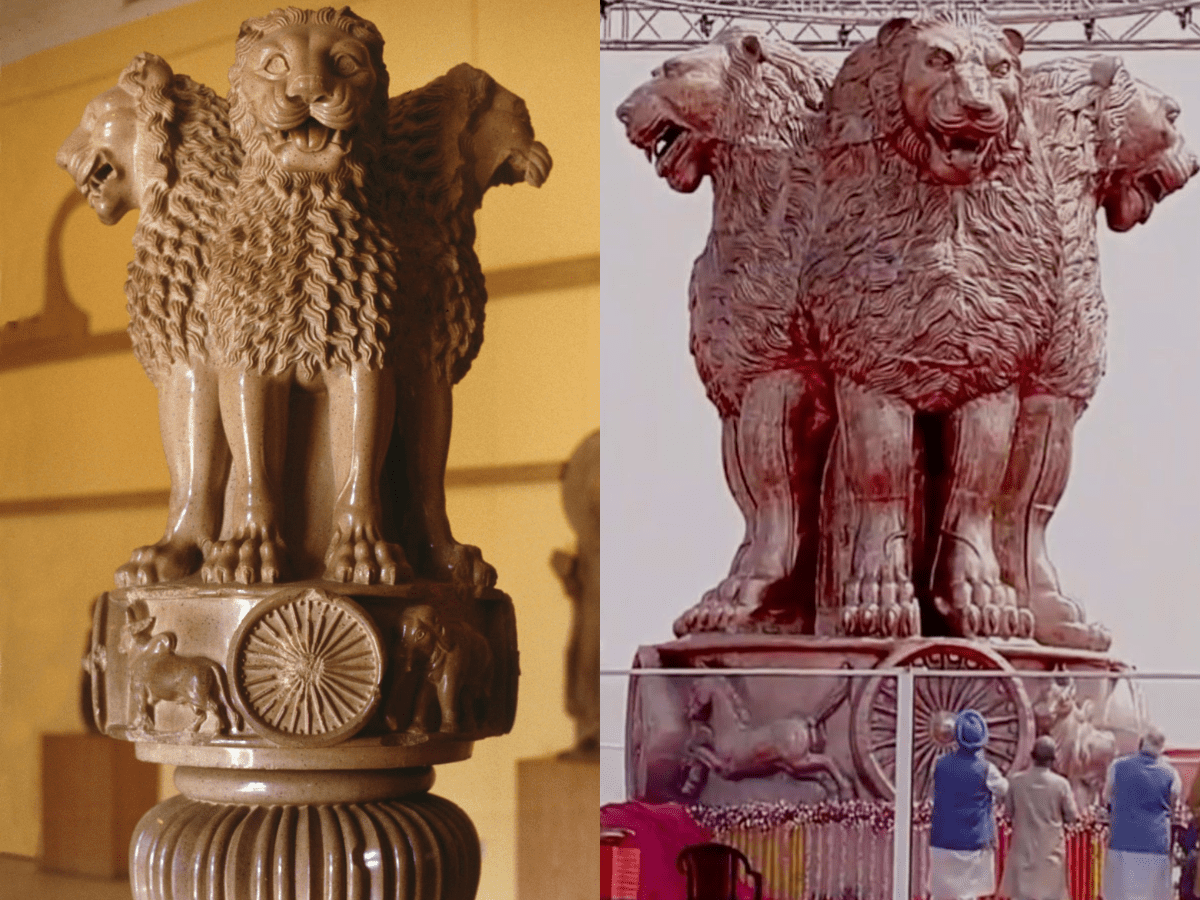
New Delhi: Animated or aggressive? Debate over the emblem atop the new Parliament building rages with several historians dismayed that the essence of the original “protective” Ashokan lions has been effaced while others say the differences are minuscule and no two pieces of art can be identical.
India’s emblematic lions have been under a close scanner since Prime Minister Narendra Modi last week unveiled the cast of the national emblem. The discourse it evoked was immediate and polarised.
According to several historians, including Harbans Mukhia, Rajmohan Gandhi, Kunal Chakrabarti and Nayanjot Lahiri, the ‘new lions’ are “dissimilar” when compared to the Ashokan specimens and don’t exude the same calm and peace.
Fellow historian Paromita Das Gupta disagreed, arguing that the lions in the recent cast look bigger and more animated, true to the animal’s character.
“The artists who created them are more than 2,500 years apart, hence the craftsmanship will understandably differ. It cannot be a carbon copy as no two works of art are identical,” the assistant professor at Hyderabad’s Mahindra University told PTI.
The differences between the new emblem and the original Lion Capital of Ashoka at Sarnath are very much visible, said Rajmohan Gandhi, a historian currently teaching at the University of Illinois at Urbana-Champaign.
“Anyone taking even a quick look at the relevant photographs can notice a difference,” Mahatma Gandhi’s grandson told PTI.
“The original work has dignity and confidence. The lions there are protective lions. The current sculpture shows anger and discomfort. Here the lions are aggressive,” he said.
Noted historian Harbans Mukhia forwarded a similar view.
“Lions are supposed to be aggressive but these lions (Ashokan) are not aggressive, they send the message of peace and protection and are benign kind of lions. The teeth are more visible in the new lions which is not so in the older ones,” Mukhia told PTI.
The showing of teeth is a strong sign of “aggressiveness” which shows the “aggressive nationalism” that is being attempted to be portrayed, he said.
This has not been done unconsciously or is artistic liberty, he said. In his view, artists do have liberty but they can’t change the basic message the piece of art wants to convey.
“The teeth are particularly aggressive here. It changes the basic nature. Modifications convey a meaning. What kind of message is this regime trying to convey? Are you transforming India from a peaceful nation to an aggressive one?”
The original lions conveyed the meaning of peace and protection, Mukhia stressed.
Kunal Chakrabarti, who retired as a professor of ancient Indian history at Jawaharlal Nehru University, said the emblem at the new Parliament building looks “different” from what has been seen for so many years.
“There is no doubt about the fact that the Sarnath lions exude inner strength and calmness,” Chakrabarti said.
He said he would have to have a look at the new emblem installed at the Parliament building more closely to make a better assessment.
“I have seen the Ashokan lions closely and they exude peace, strength, calmness and protection which a new nation should have,” he said.
“I could see the teeth are more visible (in the lions atop Parliament). I also heard the maker say on TV that they are similar, but they are visibly dissimilar, there is no doubt about that,” Chakrabarti asserted.
Ancient India expert Nayanjot Lahiri has also pointed out that the “ferocious expression” on the faces of the new lions is “qualitatively different” from the “benign aura” of their back-to back seated brethren on the Sarnath capital.
“The admirers of the novel parliamentary form can certainly claim that this is a new take on an earlier symbol. But the restraint in repose that is so unique to the lion imagery of the ancient Ashokan capital has become a casualty here,” she said in an article in the Indian Express. She added that the essence of the original has been effaced.
Arguing her point, Paromita Das Gupta said the images of the recent imitation at the new parliament building seem to carry the essential symbols or markers of the national emblem that was adopted in 1950 when India became a republic.
“The minuscule differences lie in the size/dimension of the new adaptation. The lions in the recent cast look bigger and more animated, true to the animal’s character,” she said.
“As long as the fundamental elements remain unchanged and follow the principles of the State Emblem of India Act, 2005, there is technically no significant difference between the adaptation of the Mauryan lions and the recent imitation of the national emblem,” she said.
She termed the controversy “most unnecessary” and said the “fundamental elements/symbols of the national emblem were not compromised or distorted”.
Hence the debate is pointless, and the criticisms are baseless, she said.
The opposition has accused the government of giving a “ferocious” look to the sculpture and insulting the symbol, while the BJP dismissed it as yet another “conspiracy” to target Modi.
The national emblem is an adaptation of the Lion Capital of Asoka at Sarnath. The capital was originally installed ca. 250 BCE by orders of the Mauryan emperor Ashoka atop a column in Sarnath, the site of Gautama Buddha’s first sermon.
